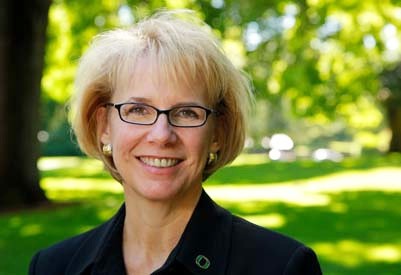A new senior vice president for research was appointed last week as the UA works to double its research expenditures in the next decade.
President Ann Weaver Hart announced the appointment of Kimberly Andrews Espy on April 15 in an email to students and faculty. Espy will assume the role of senior vice president for research beginning May 27.
Espy, who visited campus in March during her bid for the senior vice president for research position, was one of three candidates selected by the Search Advisory Committee to fill the role.
The other candidates in the nationwide search were Ingrid C. Burke, director of the Helga Otto Haub School of Environment and Natural Resources at the University of Wyoming, and James W. Tracy, vice president for research at the University of Kentucky.
Janko Nikolich-Žugich, Elizabeth Bowman Professor, chair of the department of immunobiology and chair of the Search Advisory Committee, said that all 11 members of the committee were directly appointed by Hart.
The criteria for candidates was that they be leaders with the vision and capability to meet the priorities established by the “Never Settle” strategic plan, according to Nikolich-Žugich. The plan’s goal regarding research and development is to double research expenditures at UA in the next 10 years.
Espy stood out because of her blend of experience, her ability to listen and her own understanding of the research process, Nikolich-Žugich said. He said he felt that Espy has an understanding of the federal regulations surrounding active research and how to keep the burden of those regulations off of university researchers.
Espy currently holds the position of senior vice president for research and innovation at the University of Oregon, a role she assumed in 2011. She is a trained clinical neuroscientist with a background in the study of the development of children ages 3-6. Espy, whose work was primarily funded by the National Institutes of Health, studied both normal and abnormal development in children’s ability to pay attention.
Espy said that the position of senior vice president for research was appealing because the depth and breadth of the UA’s research is remarkable, and the university is well-known for many of its programs, from the space sciences to arts and humanities.
“[The UA] is really a university on the move and really making an impact,” Espy said.
Espy added that she was impressed by Hart’s Never Settle strategic plan. She said it is exciting to join the leadership team in an environment with such a bold vision, and that the goals in the plan are well-articulated.
“The basic role of the senior vice president of research is to foster and facilitate an environment that allows faculty to do outstanding research,” Espy said.
Espy said she will, among other things, provide faculty with assistance in grant writing, regulate sponsored projects and work with deans and other vice presidents. Part of her role as senior vice president for research, Espy added, will be making sure that the research at the UA is as relevant as possible. She also said she was impressed with the involvement of undergraduates in research.
“One of the things that really struck me is the breadth of research opportunities for undergraduates,” Espy said. “I really look forward to coming to campus and facilitating those efforts as well.”
Leslie Tolbert, a UA professor of neuroscience, held the position of senior vice president for research from July 2005 until June 2013. Tolbert said the senior vice president for research has oversight over all the research projects, facilities and museums on campus. They also oversee the offices that regulated federal guidelines, such as Sponsored Projects Services and the offices of contracting on campus.
The senior vice president for research also collaborates with the president of the UA and the provost on projects, Tolbert added, and oversees the UA Graduate Interdisciplinary Programs mounted by departments in the graduate school.
“A lot of the red tape that comes with the funds for doing research is handled by those offices, and those are overseen by the vice president of research,” she said.








